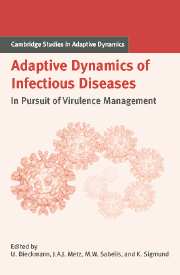Book contents
- Frontmatter
- Contents
- Contributing Authors
- List of Boxes
- Notational Standards
- 1 Introduction
- A Setting the Stage
- B Host Population Structure
- C Within-Host Interactions
- D Pathogen–Host Coevolution
- E Multilevel Selection
- F Vaccines and Drugs
- G Perspectives for Virulence Management
- Introduction to Part G
- 27 Taking Stock: Relating Theory to Experiment
- 28 Virulence Management in Humans
- 29 Virulence Management in Wildlife Populations
- 30 Virulence Management in Veterinary Epidemiology
- 31 Virulence Management in Plant–Pathogen Interactions
- 32 Virulence Management in Biocontrol Agents
- 33 Epilogue
- References
- Index
- International Institute for Applied Systems Analysis
29 - Virulence Management in Wildlife Populations
Published online by Cambridge University Press: 15 January 2010
- Frontmatter
- Contents
- Contributing Authors
- List of Boxes
- Notational Standards
- 1 Introduction
- A Setting the Stage
- B Host Population Structure
- C Within-Host Interactions
- D Pathogen–Host Coevolution
- E Multilevel Selection
- F Vaccines and Drugs
- G Perspectives for Virulence Management
- Introduction to Part G
- 27 Taking Stock: Relating Theory to Experiment
- 28 Virulence Management in Humans
- 29 Virulence Management in Wildlife Populations
- 30 Virulence Management in Veterinary Epidemiology
- 31 Virulence Management in Plant–Pathogen Interactions
- 32 Virulence Management in Biocontrol Agents
- 33 Epilogue
- References
- Index
- International Institute for Applied Systems Analysis
Summary
Introduction
Historically, control of virulence in wild animals has only been attempted when the disease threatened humans or their livestock. However, as populations of some wild animals have become increasingly rare, public demand to protect endangered species has lead to an increasing effort to control disease in wildlife. Habitat fragmentation and the ensuing edge effects have further exposed wildlife populations to exotic species and livestock that may act as vectors for infectious and parasitic diseases to which the wildlife population has not been exposed previously. Small populations are at greater risk, because the loss of individuals can reduce genetic diversity, make the population more sensitive to the natural fluctuations of the environment, and trigger a population crash as a consequence of high predation pressure or the disruption of social structure (May 1988; Hutchins et al. 1991). Moreover, these negative effects may be enhanced by the loss of immunity through the natural elimination of the disease at low population densities. If the disease is then accidentally reintroduced into the now immunologically naive population, hosts may suffer a higher level of mortality with respect to epidemics of previously endemic diseases (Cunningham 1996).
In this chapter, we first present a simple formula to estimate the time for virulence or resistance to evolve. Then, after a brief consideration of the potential consequences of vaccination programs on the evolution of resistance, we briefly review some of the reasons why wildlife virulence management is still a science in its infancy.
- Type
- Chapter
- Information
- Adaptive Dynamics of Infectious DiseasesIn Pursuit of Virulence Management, pp. 413 - 424Publisher: Cambridge University PressPrint publication year: 2002
- 2
- Cited by



